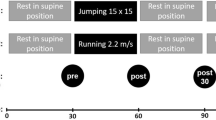Abstract
Marathon running is frequently associated with numerous cellular changes, but little information is available on the effects of exercise-mediated prolonged impact-stress on cartilage integrity. This study was undertaken to evaluate muscle and cartilage damage with different running distances. Twenty male marathoners and ultra-marathoners participated in the study. Serum COMP and plasma CPK and hs-CRP were measured as markers of cartilage and muscle damage and inflammation. Serum COMP was increased 1.6-fold at 10 km during a marathon race and declined to the pre-race level after 2 days recovery. In contrast, serum COMP was increased 1.9-fold after a 200-km race and maintained until day 3 of recovery, only returning to the pre-race level on day 6. Plasma CPK was increased at 10 km of the marathon race and up to threefold at the end of the race. This was further increased on day 1, only returning to pre-race level on day 6. Plasma CPK was increased 35-fold at the end of the 200-km race and remained increased until day 5. There was no change in plasma hs-CRP during the marathon race, but this was increased 3.4-fold by day 1, returning to the pre-race level on day 4. Plasma hs-CRP increased 40-fold by the end of the 200-km race and was still increased on day 6 of recovery. Therefore, longer distance running may induce more impact-stress both on muscle and cartilage. Further, the required time for recovery may vary with running distance and the tissue type, e.g. cartilage or skeletal muscle as in this case.





Similar content being viewed by others
References
Clarkson PM, Nosaka K, Braun B (1992) Muscle function after exercise-induced muscle damage and rapid adaptation. Med Sci Sports Exerc 24:512–520
Dill DB, Costill DL (1974) Calculation of percentage changes in volumes of blood, plasma, and red cells in dehydration. J Appl Physiol 37:247–248
Eckstein F, Lemberger B, Gratzke C, Hudelmaier M, Glaser C, Englmeier KH, Reiser M (2004) In vivo cartilage deformation after different types of activity and its dependence on physical training status. Ann Rheum Dis 64:291–295
Fallon KE, Sivyer K, Dare A (1999) The biochemistry of runners in a 1,600-km ultramarathon. Br J Sport Med 33:264–269
Frey W, Wassmer P, Frey-Rindova P, Colombani P, Arnold M, Villiger B (1995) Correlation between muscle damage (creatine kinase) and acute phase reaction (C-reactive protein) after extreme exercise. Rheumatol Eur 24:47
Kersting WG, Stubendorff JJ, Schmidt MC, Brüggemman G (2005) Changes in knee cartilage volume and serum COMP concentration after running exercise. Osteoarthritis Cartilage 13:925–934
Kim HJ, Lee YH, Kim CK (2007) Biomarkers of muscle and cartilage damage and inflammation during a 200-km run. Eur J Appl Physiol 99:443–447
Kuipers H (1994) Exercise-induced muscle damage. Int J Sport Med 15:132–135
Lequesne MG, Dang N, Lane NE (1997) Sports practice and osteoarthritis of the limbs. Osteoarthritis Cartilage 5:75–86
Mündermann A, Dyrby CO, Andriacchi TP, King KB (2005) Serum concentration of cartilage oligomeric matrix protein (COMP) is sensitive to physiological cyclic loading in healthy adults. Osteoarthritis Cartilage 13:34–38
Neidhart M, Muller-Ladner U, Frey W, Bosserhoff AK, Colombani PC, Frey-Rindova P, Hummel KM, Gay RE, Hauselmann H, Gay S (2000) Increased serum levels of non-collagenous matrix proteins (cartilage oligomeric matrix protein and melanoma inhibitory activity) in marathon runners. Osteoarthritis Cartilage 8:222–229
Nieman DC, Dumke CL, Henson DA, McAnulty SR, Gross SJ, Lind RH (2005) Muscle damage is linked to cytokine changes. Brain Behav Immun 19:398–403
Noakes TD (1987) Effect of exercise on serum enzyme activities in humans. Sports Med 4:245–267
Pedersen BK, Hoffman-Goetz L (2000) Exercise and the immune system: regulation, integration and adaptation. Physiol Rev 80:1055–1081
Perry JD (1992) Exercise, injury and chronic inflammatory lesions. Br Med Bull 48:668–682
Petersen AM, Pedersen BK (2005) The anti-inflammatory effect of exercise. J Appl Physiol 98:1154–1162
Pue CA, Mortensen RF, Marsh CB, Pope HA, Wewers MD (1996) Acute phase levels of C-reactive protein enhance IL-1 beta and IL-1ra production by human blood monocytes but inhibit IL-1 beta and IL-1ra production by alveolar macrophages. J Immunol 156:1594–1600
Rosenberg K, Olsson H, Mörgelin M, Heinegård D (1998) Cartilage oligomeric matrix protein shows high affinity zinc-dependent interaction with triple helical collagen. J Biol Chem 273:20397–20403
Smith RK, Birch HL, Goodman S, Heinegård D, Goodship AE (2002) The influence of ageing and exercise on tendon growth and degeneration—hypotheses for the initiation and prevention of strain-induced tendinopathies. Comp Biochem Physiol A Mol Integr Physiol 133:1039–1050
Temple C (1992) Sports injuries. Hazard of jogging and marathon running. Br J Hosp Med 1983:237–239
Tosch U, Sander B, Schubeus P, Eckart L, Felix R (1991) Magnetic resonance tomographic and sonographic imaging of the ankle in marathon runners. Rofo Fostschr Geb Rontgenstr Neuen Bildgeb Verfahr 154:150–154
Acknowledgment
This work was supported by a research grant (2008) from Korea National Sport University.
Author information
Authors and Affiliations
Corresponding author
Rights and permissions
About this article
Cite this article
Kim, H.J., Lee, Y.H. & Kim, C.K. Changes in serum cartilage oligomeric matrix protein (COMP), plasma CPK and plasma hs-CRP in relation to running distance in a marathon (42.195 km) and an ultra-marathon (200 km) race. Eur J Appl Physiol 105, 765–770 (2009). https://doi.org/10.1007/s00421-008-0961-x
Accepted:
Published:
Issue Date:
DOI: https://doi.org/10.1007/s00421-008-0961-x




